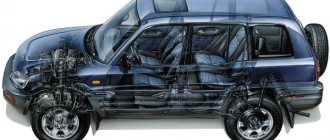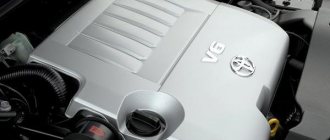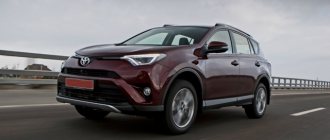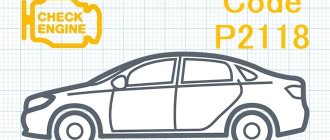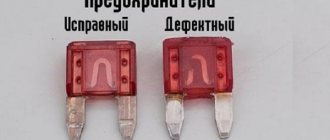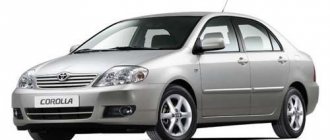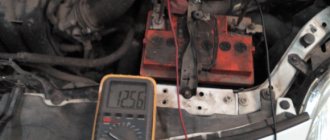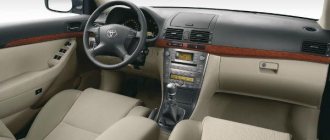All-wheel drive is the design of a vehicle transmission, which is designed to distribute torque to all wheels of the vehicle. Initially, all-wheel drive was used only on off-road all-terrain vehicles. Now such a system is found on crossovers and some station wagons.
The advantages of all-wheel drive are: • increased cross-country ability; • high adhesion qualities to the road surface; • good handling.
Toyota Highlander
But there is one serious drawback. The design of all-wheel drive is quite complex, so all-wheel drive cars usually cost much more than cars with one drive axle. Fans of all-wheel drive will have to fork out the cash not only when buying a car, but if it needs to be repaired. However, everyone chooses a car based on their budget.
But we need to talk in more detail about how all-wheel drive works.
Permanent all-wheel drive
The principle of operation of such a drive is as follows: from the power unit, torque goes to the transfer case, from the transfer case it is transmitted to the differential - an element that is designed to distribute force to the front and rear pair of wheels of the car. After this, through the cardan, the force goes to the cross-axle differentials and goes to the wheels.
The center differential, as well as similar cross-wheel devices, tend to lock. This is necessary if the machine hits one or more wheels, for example, on an unreliable surface.
Permanent all-wheel drive is actively used, mainly on German cars from leading manufacturers: Audi, BMW, Mercedes.
Automatic all-wheel drive
The friction clutch is the main element of such a system. In general, with connected all-wheel drive, if the grip on the road is at least satisfactory, the components of the car work in approximately the same way as the components of a car with one drive axle. Provide power transmission to the gearbox and clutch. Literally, the minimum amount of torque is transmitted to the rear axle. But, if the road grip deteriorates. For example, if slipping occurs, then the process of increasing pressure in the main element - the clutch - occurs, which in turn leads to the transfer of forces to the rear pair of wheels. Its value may vary depending on the traffic situation.
The most famous and popular automatic all-wheel drive system is called 4Motion.
Technical specifications Toyota RAV4 2.0 4WD
So far, the majority of Toyotas on the roads are 3rd and 4th generations RAV 4 VD. The five-door station wagon weighs 1,510 tons, with a full tank - 1,560 tons. Its gross weight is 2,105/2,155 tons. The maximum trunk volume is 1,189 liters, in compact form - 580 liters. RAV4 4 VD accelerates to 100 km/h in 9.9-11 seconds and has a top speed of 190 km/h.
Dimensions of the RAV 4wd are 4.6 m in length, 1.855/1.685 m in width and height, respectively. The front/rear track span is 1,610/1,640 m with a ground clearance of 19.5 cm.
RAV4 Engine and Transmission Specifications:
- volume 1,987 cm3 - with a compression ratio of 13;
- by injection type - direct, turbocharged;
- in-line, 4-cylinder with 16 valves;
- cylinder piston stroke 97.6x80.5 mm;
- power - 175 hp. With. — at rpm 6.6 thousand;
- torque - max 4,300-5,200 rpm, Nm 208;
- transmission 4wd manual transmission6/variator.
Suspension and brakes RAV 4 on 4WD:
- front/rear MacPherson/multi-link suspension;
- wheels 5×114.3ET45d60.1;
- front/rear ventilated/disc brakes.
4wd fuel consumption per 100 km in the urban/suburban cycle is in the range of 6.8-7.7/5.3/5.4, respectively, in the combined cycle - 5.8-6.2. The fuel consumed by the RAV4 is AI95, the capacity of the filling tank is 55 liters.
In 2015-2017 The RAV 4wd model began to gain popularity and in 2018 became one of the most popular among Toyota owners.
Manual all-wheel drive
Its operating principle is similar to the principle on which a permanent drive operates. With the exception of one point: there is a special lever in the car interior that controls the transfer case.
It is believed that modern cars are not equipped with such a drive system. However, some brands and models can be cited as an example: Renault Logan. The car has a special mode switching regulator: front-wheel drive, automatically connected all-wheel drive, all-wheel drive connected manually.
It is worth noting that manually activated all-wheel drive cannot be used for a long time. This, as a rule, leads to overheating of the coupling and its failure.
Second generation 4WD Rav 4 design
For the second generation Toyota Rav 4, a new type of 4WD was used. The all-wheel drive design is made according to the STD II . It involves blocking the center differential using a viscous coupling.
STD 2 circuit
This design was previously used on Toyota cars, where mechanics were installed as a transmission. Despite the significant simplification of the design compared to the first generation models, reliability remained at the same level. At the same time, there is a significant decrease in characteristics.
The design provides for the combination of the center and front differential between the wheels. At the same time, five satellites are mounted in the latter. In normal operation, the Torsen rear limited-slip differential is not loaded, but can be forced into gear.
Toyota Previa. Operating principle of all-wheel drive
Toyota Previa
The operating principle of all-wheel drive on the Previa model from Toyota is interesting. Cars. As a rule, in nature there are already quite old ones, therefore their all-wheel drive organization is special. Despite the fact that all-wheel drive operates constantly, the design contains a viscous coupling, which is responsible for blocking cross-axle differentials if such blocking becomes necessary. This drive design is not entirely standard. However, the Previa is a car that can no longer be called modern. But on domestic roads it is found in different modifications.
New technology not available on all Toyota RAV4 vehicles
The phrase “Tork Vectoring” is usually applied to sports cars, but the new crossover breaks the established stereotypes. The difference in traction on the wheels at the moment of entering a turn not only increases the speed of cornering, but also stabilizes the trajectory. Therefore, the latest modification of the Toyota Rav 4 is a bit like a sports car. However, the main goal pursued by the manufacturer is, first of all, to improve the off-road performance of the car.
Imitating the locking of the rear cross-axle differential solved the problem with diagonal hanging. The wheels will no longer skid in vain, and when driving along a country road, AWD will transfer torque to those wheels where it is most needed for confident and safe movement. In basic trim levels, the Toyota RAV4 is equipped with old-style intelligent all-wheel drive. The new Dynamic Torque Vectoring AWD is currently only available as an option for the Prestige trim level and above.
How all-wheel drive works on a Highlander
There is heated debate about what kind of all-wheel drive is installed on the Highlander. This is partly due to the fact that there are several versions of the machines. The second reason is the ambiguity of opinions regarding how torque is distributed between the axles.
Older versions of the car are equipped with a drive with a viscous coupling, which is designed to block the differential. More recent versions of the car of this model are equipped with an SCV stabilization system, which performs the tasks of a viscous coupling - blocking wheels that have gone into the axle box and braking them.
It is believed that Highlander cars are equipped with permanent all-wheel drive, where the distribution of forces along the axles is 50 to 50. Many car owners tend to believe that 60 percent of the torque is distributed to the front axle. This naturally applies to the previous generation of the car. New cars have a free differential, so the torque goes to the axle where it is needed.
Great Wall Hower
Leather, V6 and permanent (!) all-wheel drive: experience of owning a 2007 Toyota Sienna
Owner
– Alexey Solovyov, Muscovite, 28 years old, auto mechanic.
Car
– Toyota Sienna 2007, 2nd generation, restyling, all-wheel drive, “American”.
Alexey says:
– At a certain point in my life, I became interested in a family car with 6-7 seats. Having started to study the secondary market, I became convinced that such cars in a moderate price range (up to a million rubles) are in short supply... There are not so many offers - if we discard too old cars, right-hand drive and purely American brands, for the ownership of which it is desirable to be a fan of them, then there are only five or six models left, very poorly represented on sales advertisement sites. At the same time, in half of the models, the interior, disassembled to seven seats, almost completely eats up the trunk volume, and it is not clear where to put the things of such a group...
I found this Sienna in a trade-in at one of the largest Moscow car dealers. They asked 600,000 rubles for it. At first it made me wary - the car had a lot of paint on the body, the mileage was over 200,000, and the tax was quite high due to the powerful engine. Those who are looking for a family car worth up to a million are usually scared off by such things, but I still decided to try to make friends with this car and I was right!
The seven-seater interior was combined with a decent trunk even with the third row unfolded, a lot of different options and just little things for comfort, all-wheel drive transmission, electric drives for both sliding side doors and a lifting rear door, a dynamic V-engine with automatic transmission, one owner in the USA (from the purchase of a new car in 2007 and until 2010 and 60 thousand miles) and one in Russia (from 2010 until recently, up to 150 miles) - not a single minivan that I studied during my search had such a set of advantages, and It was decided to buy a Sienna!
Outside
By modern standards, one can say about Sienna’s appearance “there’s nothing to catch the eye on!” Scurrying along the highway here and there, fresh Camrys, CHAs and Lexuses from the latest model ranges with elaborate shapes, reminiscent of the result of an epileptic fit in an origami master, clearly hint at the age of our car, which reveals its rustic appearance, very far from the current design delights of Toyota.
But a 13-year-old minivan is chosen not with the heart, but with the mind, and the buyer of such a car is completely calm about its discreet appearance, finding beauty in discreet outlines and calm harmony. Flat doors without fashionable rapid stampings are slightly enlivened by moldings with chrome inserts, a narrow chrome “saber” adorns the radiator, and another small sparkling blade is the rear door. Modest optics complete the picture, about which we can say that the main tone in it is set by the imaginary hieroglyph “An”, meaning “calm”. It is impossible to imagine the Sienna flying through a red light, not allowing pedestrians to pass, or filling the surrounding area with the sounds of hip-hop. This is a car for those who understand life and are not in a hurry! Although if you need to hurry, she will not fail!
1 / 6
2 / 6
3 / 6
4 / 6
5 / 6
6 / 6
Inside
Yes, it’s a little boring on the outside, but we’ve already decided that in this case all the fun is inside, like in the old advertisement for Intel processors! Well, first of all, of course, it's a leather interior! It was perfectly preserved and after dry cleaning showed itself in all its glory. Thick natural white leather without any cheap “eco” prefixes, combined with a rich plastic “walnut root” finish, looks and feels high quality and expensive, despite its age. And coupled with white and grayish plastic, as befits light colors, it visually expands the already very spacious interior.
1 / 5
2 / 5
3 / 5
4 / 5
5 / 5
The instrument panel is an impeccably readable, timeless classic, easy to use day or night, and from any viewing angle. The dominant markings on the speedometer in miles, as well as the compass in the top panel of the trip computer, indicating the direction in which the nose of the car is oriented, indicate American origin.
The standard multimedia system is very developed and multifunctional. It includes a head unit with a touchscreen display, navigation, rear camera support, Bluetooth phone connectivity with volume controls, radio stations, tracks and call answering/hanging up on the steering wheel.
1 / 5
2 / 5
3 / 5
4 / 5
5 / 5
Due to its age, there is no support for flash drives and memory cards yet, but in a visible place there is an input covered with a rubber plug for connecting the player via a 3.5 mm jack. Above it is a button to turn on the high-voltage inverter, which we will mention later.
The high-quality component audio system, including a center channel speaker and subwoofer, is equipped with JBL heads.
Residents of the rear rows have access to an overhead folding monitor with a DVD player, audio broadcast from which can be sent to wireless headphones without interfering with the driver and passenger to the right listening to music. There is also a socket with audio/video “tulip” inputs for connecting a portable player or game console.
1 / 4
2 / 4
3 / 4
4 / 4
The second row – two “captain’s” chairs, separate and very comfortable: natural business class as it is! Each chair has two armrests, separately adjustable. The third row is more modest, but not “dog-friendly”, like in many minivans, where it is nominal - cramped and uncomfortable even for children. In the Sienna, in the back row there is a full-fledged three-seater sofa, like in any good sedan: with soft cushions and a backrest, with three adjustable headrests! The heating/cooling for the rear row is also very efficiently organized.
1 / 3
2 / 3
3 / 3
From the second row there is free passage to the third - very convenient if you need to rummage through bags or calm the children. The middle row seats can be completely removed if necessary, and the rear ones can be folded into the floor. The rear row backrests can be folded in a 60/40 ratio. When folded, the backs of the middle row form tables with niches for glasses of drinks and road fast food.
The side doors are sliding, and both are equipped with electric drives. The rear door lifts up and also moves using electric actuators. The buttons for controlling all three doors are located in the ceiling above the driver’s head, in a common block with a hatch opening control rocker. The rear windows also open slightly using electric drives!
1 / 3
2 / 3
3 / 3
The car has a huge number of different pleasant little things - both in terms of electrical functionality and various practical cabin amenities. All imaginable electrical package, including memory of driver’s seat settings, rear passengers’ own air conditioning control panel under the ceiling near the head of the left middle row passenger, tire pressure sensors, parking sensors with a camera, etc.; standard window nets, a huge multifunctional armrest between the front seats, a lot of different trays and compartments for things, folding hooks for packages and bags, almost a dozen slots for glasses and bottles scattered throughout the cabin, and many other “Ikea” utilities, making long trips more comfortable.
For example, both in the front and rear of the cabin there are two 115-volt AC outlets, the built-in inverter for powering them is turned on by a button on the dashboard. And if you think that American standard voltage is useless in Russia, you are mistaken! A fair amount of modern 220-volt equipment with switching power supplies allows operation in a very wide voltage range - from 100 to 240 volts. So the most popular network devices in a car - chargers for phones, laptops and all portable equipment, electric shavers and other small equipment that do not have a 12-volt or USB analogue - can be easily used! You only need an adapter from an American standard socket with flat pins to a European one with round pins.
1 / 4
2 / 4
3 / 4
4 / 4
Iron
The engine of this Sienna is a V-shaped 6-cylinder naturally aspirated 2GR-FE. It was also installed on Highlanders, Venzas, Alphards, etc. Power 269 horsepower, volume 3.5 liters, torque up to 350 nm, traditional distributed injection, phase adjustment on the intake and exhaust.
In routine maintenance, the engine cannot be said to be too convenient... To remove the oil filter housing, a special cup wrench is required (and ideally, also a special tube to drain the remaining oil from the filter, although this is not necessary); To replace the spark plugs, you will have to carry out partial disassembly and remove the intake manifold - due to the transverse location of the V-shape. Although, of course, these are not decisive aspects when choosing a car...
Much more significant is the frequent problem with the fifth cylinder - the valve guide and seat are destroyed, compression drops, and scuffing occurs. There are still heated debates about the reasons in the Toyota community and repairmen, and Toyota issued a couple of bulletins recognizing the problem: some recommendations related to the type of oil, some related to the air filter…. Some people blame the EGR valve, others the types of pistons that were changed in different revisions of this engine... However, it is worth noting that a Sienna with a 2GR-FE engine is much less susceptible to the problem than, for example, Lexuses with him. On this example, at a mileage of 200,000, everything is normal with compression and oil pressure.
Transmission: Aisin five-speed hydraulic automatic. A reliable automatic transmission, which, given the “Toyota” driving style (which is also aggravated in a good way by the family nature of the car), is capable of lasting up to 300 thousand or more without major overhauls, if you periodically change the oil and ignore the manual that suggests changing the fluid “only if necessary”, caused by repairs or severe operating conditions.
All-wheel drive in the Sienna is a permanent, non-disconnectable VSC+ type according to Toyota’s internal classification, the same one found on the Highlander, Harrier and Lexus RX crossovers of the same years. By default, the torque is distributed in a 50/50 ratio, while the central differential is free, without any locking. In case of driving into the mud, an imitation of locking is provided by braking the slipping wheels, although for an additional fee Sienna buyers could still order central locking with a viscous coupling.
Of course, there is no reduction row and inter-wheel locks here at any price, just as there are no controls. The design does not contribute to fuel economy (more on this below), but it is as simple as possible and suitable for light off-road driving.
If we talk about repairs, then the current owner of the Sienna has not yet caused any trouble. The engine, transmission and suspension were normal at the time of purchase, except that there was increased play in the steering wheel due to wear on the rack. The air conditioner did not work, but, oddly enough, everything was solved by a simple refueling - no leaks were found. The main efforts were made on the “cosmetics”: they polished the cloudy headlights, repainted the bumpers, and carried out high-quality dry cleaning of the interior.
In move
A car made for the USA, and also aimed at families, a priori means an impressive degree of comfort for both passengers and captain. The chic driver's seat with a steering wheel adjustable in two planes can easily be adjusted to any height and build - except that lateral support, according to American tradition, is slightly lacking. Visibility through the windows and mirrors is excellent, the dimensions feel great even without taking into account the presence of cameras/parking sensors. Noise insulation is not bad, although it cannot be called exemplary: after 120 km/h noticeable noise begins to break through the windows and hatch - the glazing area is large.
The powerful V-shape gives the Sienna a liveliness that you don’t expect from a family car that is far from racing ambitions. No, this is not a sports car, of course, but the dynamics allow you to honestly, without guile, enjoy working with the right pedal, and not vomit in the truck lane. American-style traction starts from the bottom, and the engine’s power reserve is enough so as not to constantly jerk the gearbox by switching to lower gears, including when driving a fairly loaded car uphill. In fifth gear, up to 130-140 km/h, the revolutions do not exceed 2500, and up to these speeds, the response to the car’s pedal generally changes slightly depending on the load - the Sienna doesn’t care whether it’s dragging one driver or a whole team of passengers with luggage. At higher speeds, the workload, of course, already has an effect: the car becomes “dull”, and prolonged driving becomes not very pleasant.
The response to the steering wheel could have been sharper, but in this case it is partly due to the aforementioned and still unresolved rack play. In a straight line, the car literally goes like a cruiser, ignoring ruts and the influence of side winds on the “sail” of the long five-meter body. The suspension resembles pneuma - any unevenness and potholes are swallowed by it unnoticed by the backs and spines of passengers, although the body is still prone to some lateral swing at high speeds. And the high (185 mm) ground clearance on 17-inch wheels allows you to calmly climb curbs and not be afraid of tearing off the bumpers in alleys that are poorly cleared of snow. The brakes (all-round discs, although there were versions with rear drums on the monodrive) are excellent for driving alone or with two people, but with a full interior the braking distance can be unpleasantly surprising, which should not be forgotten.
Fuel consumption somewhat moderates the delight caused by the spaciousness and comfort of the cabin, as well as the softness of the ride. In city mode, 13-14 liters per hundred is the norm... But even with a quiet ride on a free country highway, it is difficult to burn less than 11-12 liters, and with a full load (4-6 passengers + luggage) on the highway it easily goes up to 14- 15 liters. After 120-130 km/h, the consumption begins to grow rapidly and nonlinearly - the aerodynamics of a large car affects it. So it’s better to enjoy a powerful engine during acceleration and short pickups, and not on straight stretches, although even a well-worn Sienna goes up to 170-180 without much strain, completely corresponding to the rightmost number on the speedometer. In principle, many people use 92-grade gasoline in this engine, but 95 is still optimal.
Model history
For any automaker, conquering the bottomless American market is a true dream. In 1997, Toyota decided to seriously encroach on a share of the wide minivan segment in the United States, where the super-popular Chrysler Voyager, produced since 1988, including under the names Plymouth Voyager and Dodge Caravan, ruled the roost. First generation
The Toyota Sienna, built on the stretched platform of the front-wheel drive Camry sedan, was initially created with an eye on the USA and the love of local buyers for solid V-shaped engines, because the Previa minibus already in the manufacturer’s arsenal did not allow the installation of such a unit due to its layout. As a result, the new product was well received by US buyers thanks to a powerful and responsive 3-liter 194-horsepower engine, an automatic transmission handle under the steering wheel familiar to overseas drivers, a well-thought-out interior transformation system with 7 or 8 seats, rich equipment, as well as excellent results in crash tests .
Toyota Sienna (XL10) '1998–2003
Based on the results of seven years of sales of the first generation, the minivan was seriously improved, taking into account the accumulated feedback from customers and dealers, and in the second generation
, produced since 2003, began to meet literally all the wishes of the target audience. The car has grown in length by a couple of tens of centimeters, becoming more spacious in the legs, received a lot of new options for driving comfort and riding as a passenger, the power and engine volume have increased (first to 3.3 liters / 230 horsepower, and after restyling in 2007 - to 3. 5 liters/269 horsepower), a fifth stage was added to the previously 4-speed automatic transmission, and, importantly, a version with permanent all-wheel drive appeared!
Toyota Sienna (XL20) '2004–10
Third generation
came to American buyers in 2010 (although “arrived” is not a completely appropriate term, since all generations of Sienna were assembled at Toyota’s American factories in Kentucky and Indiana). The car continued to improve in its role as a successful regular on the American market, and the manufacturer’s confidence in the authority it had earned in the minivan segment in the New World even allowed it to take a risk and offer a modern in-line “four” paired with the irreplaceable and relatively outdated V-shaped “six”. However, consumers ignored this engine, and Toyota quickly returned to the engine familiar from the second generation. The creators of the third Sienna also worked very seriously on its appearance - the car acquired a lot of expressive nuances in the shape of body panels and optics, ceasing to be boring like the second generation. The drive remained available, both front and all-wheel drive (although the scheme changed from permanent to plug-in), the automatic transmission received eight gears.
Toyota Sienna (XL30) '2011–2020
Fourth generation
was introduced in 2021. The appearance of the Sienna-IV has become futuristic, in the spirit of Lexus crossovers, but all this pales against the background of the fact that in the newest generation the minivan has become “hybrid only” - there will no longer be any other engine options! The 2.5-liter naturally aspirated engine of the new Sienna produces 246 horsepower paired with an electric motor in the front-wheel drive version, and in the all-wheel drive version another motor is added to the rear axle.
Toyota Sienna '2020
The principle of operation of all-wheel drive on Hover
The Chinese Great Wall Hower car is very popular not only because it is quite reliable and looks good, but also because it has all-wheel drive. The Chinese automotive industry is based on the developments of world leaders in this field. Therefore, the all-wheel drive system is built in an interesting way. Firstly, Hover is equipped with an intelligent all-wheel drive system. Secondly, the all-wheel drive structure also includes an electric coupling. The rear axle is connected using a special twister located in the cabin. Otherwise, the front-wheel drive Hover does not have any serious features.


